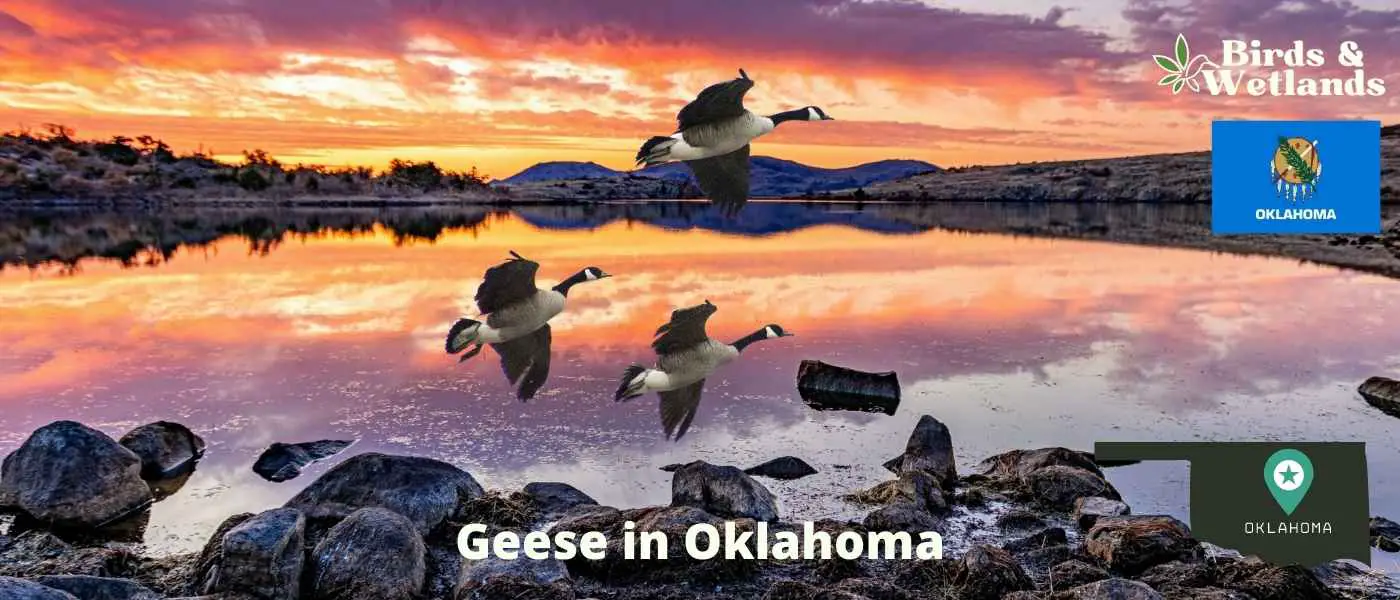Did you know that Oklahoma is home to a variety of geese species? In this definitive guide, we will discuss the different types of geese that can be found in the Sooner State, as well as their habits and preferred habitats.
What Type of Geese Are in Oklahoma?
There are five main types of geese species found in Oklahoma, though some of these have subspecies like the Giant Canada geese and the greater and lesser snow goose.
- Cackling Goose
- Canada Goose
- Greater White-fronted Goose
- Ross’s Goose
- Snow Goose
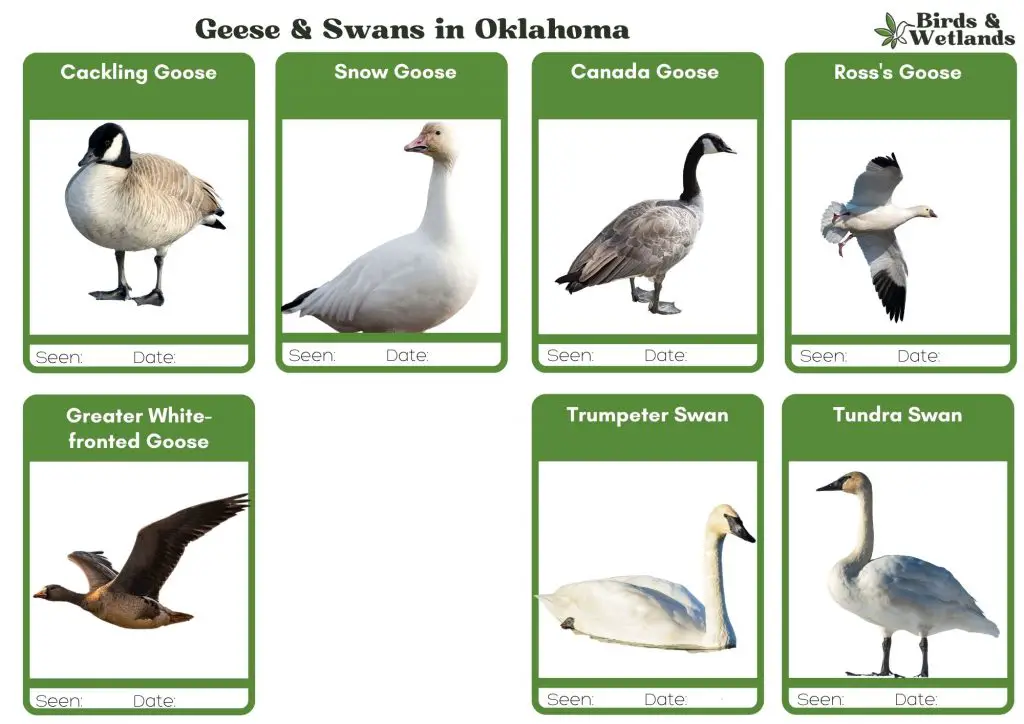
Cackling Goose
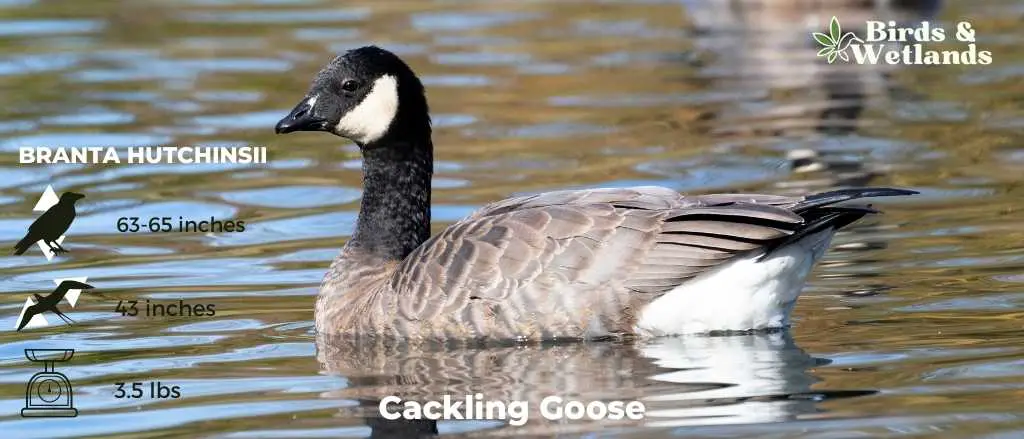
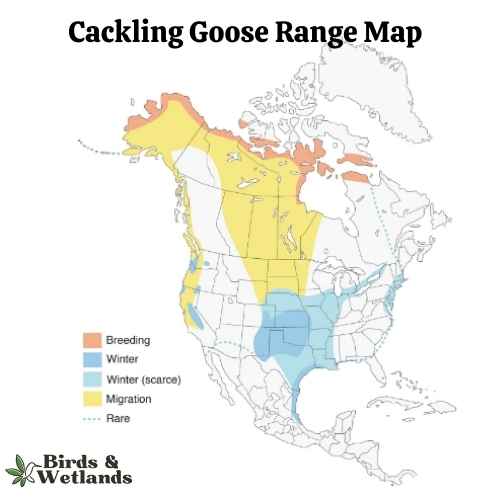
Listen
Scientific Name: Branta hutchinsii
Length: 24.8–25.6 in
Wingspan: 43-45.7 in
Weight:3.5 lbs
Cackling Geese are particularly known for their high-pitched, cackling calls, which is the source of their name. Despite their small size, these geese are renowned long-distance migrants, with some populations traveling thousands of miles between breeding and wintering grounds.
Appearance: With a similar color pattern to the larger Canada Goose, the Cackling Goose features a black head and neck, white chinstrap, light tan to cream chest, and brownish-grey body. One defining characteristic is its noticeably smaller size and stubbier neck compared to its larger counterparts.
Diet: Like many geese, the Cackling Goose’s diet mainly consists of plant matter. This includes grasses, seeds, and aquatic vegetation. They are often seen grazing on land or dabbling in shallow water.
Reproduction: Cackling Geese usually nest on the ground in elevated areas near water bodies, such as riverbanks or lakeshores. The female lays a clutch of 2 to 8 eggs and is responsible for incubation, while the male stands guard nearby. Incubation lasts for about a month.
Canada Goose
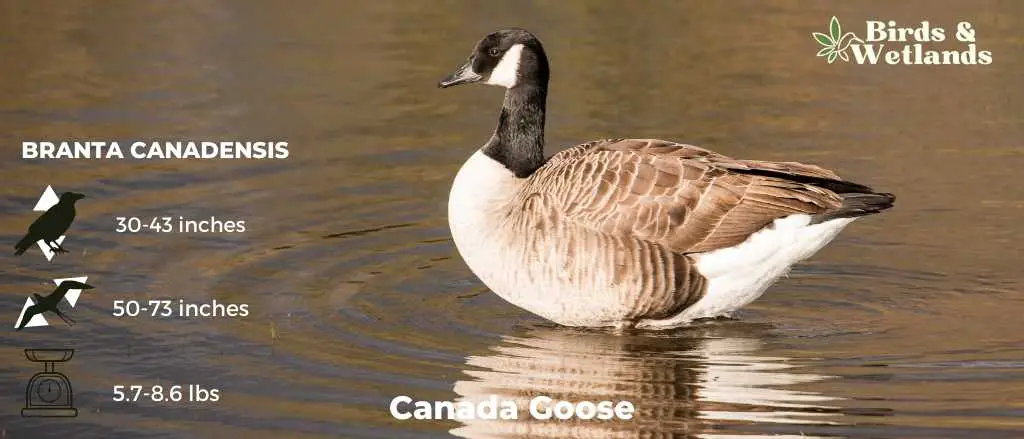
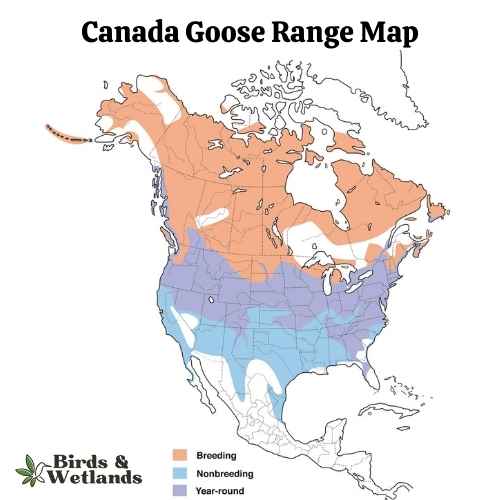
Canada Goose Sound
Scientific Name: Branta canadensis
Length: 30 to 43 in
Wingspan: 50–73 in
Weight: 5.7–14.3 lb
The Canada Goose is a large, well-known species of waterfowl noted for its distinctive appearance, familiar “honk,” and migratory behavior.
Appearance: Both male and female Canada Geese have a similar appearance, featuring a black head and neck with distinctive white patches on the cheeks and chin. The body is primarily brown with a lighter, often white, underbelly.
Diet: Canada Geese primarily feed on plant matter, including grasses, aquatic vegetation, and grains. They can often be seen grazing in parks, lawns, and fields, as well as dabbling in water bodies.
Reproduction: Canada Geese typically nest on the ground near water bodies, often on islands or other isolated areas to avoid predators. The female lays a clutch of about 4 to 6 eggs, which she incubates alone for around a month.
Greater White-fronted Goose
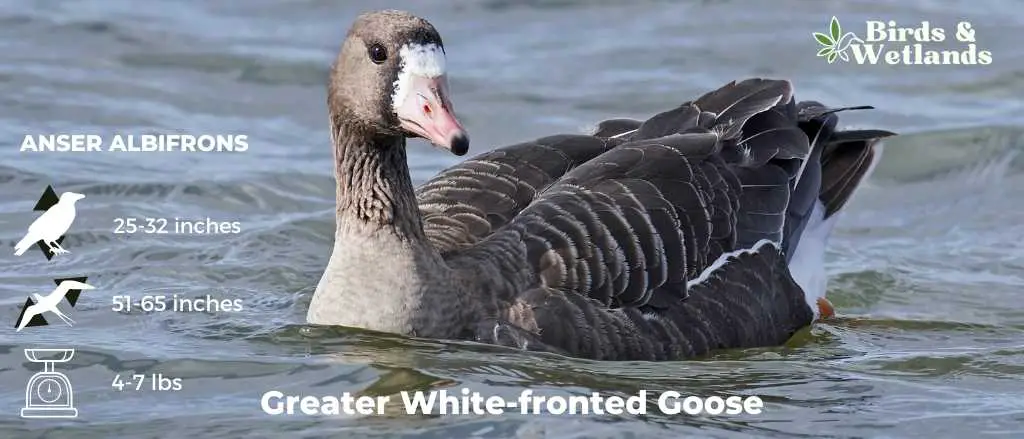
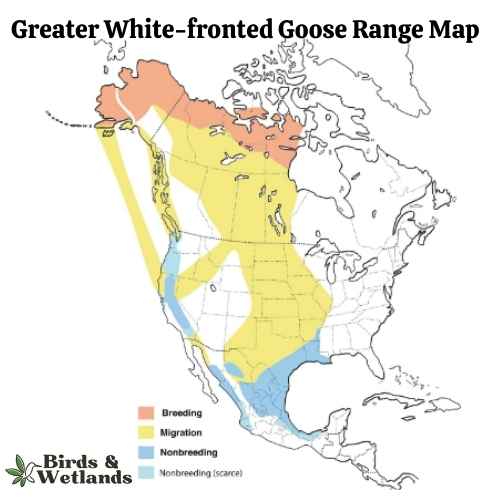
Listen
Scientific Name: Anser albifrons
Length: 25 to 31 in
Wingspan: 53 to 66 in
Weight: 3.3 to 6.6
The Greater White-fronted Goose is a medium to large waterfowl species, widely distributed across the Northern Hemisphere, particularly in North America.
Appearance: As the name suggests, these geese display a prominent white patch at the base of their bill. Their bodies are gray-brown, and their breasts are often marked with dark blotches. They possess a pinkish bill and orange legs and feet.
Diet: The Greater White-fronted Goose is a herbivore and feeds mainly on plant material. Its diet consists of grasses, sedges, grains, and berries. When wintering, these geese can often be found in agricultural fields, feasting on leftover grains and crops.
Reproduction: This species nests on the ground, often in areas with good visibility such as slopes or ridges. The female lays a clutch of 4 to 5 eggs, which she incubates for nearly a month. Once hatched, the young ones are taken care of by both parents until they are able to fly.
Ross’s Goose
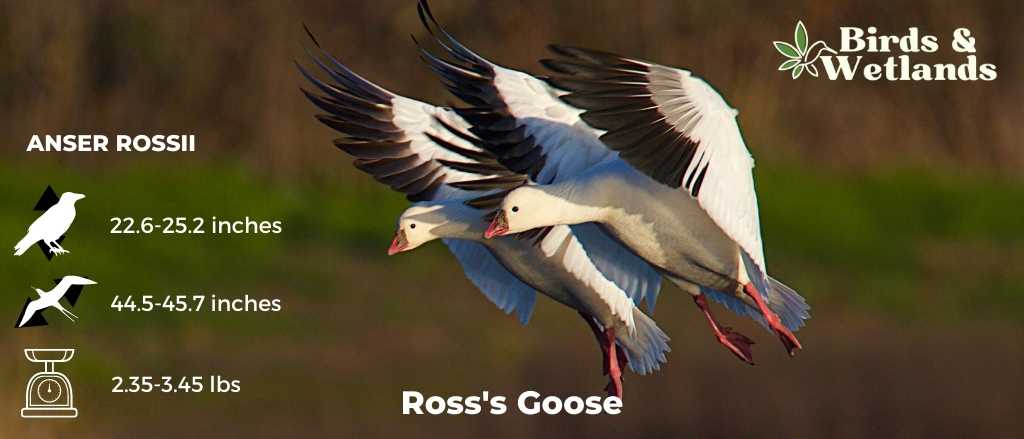
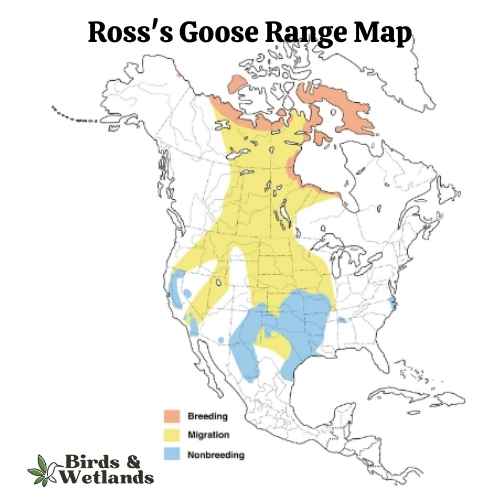
Listen
Scientific Name: Anser rossii
Length: 23.2-25.2
Wingspan: 44.5-45.7 in
Weight:42.3-55.3 oz
The Ross’s Goose is a small species of waterfowl often found in North America’s tundra and wetland habitats.
Appearance: Known for its compact size, the Ross’s Goose is mostly white with black wingtips. It features a short, stubby bill and a rounded head. One key identifying feature is the blueish gray base of its bill, which has a warty structure during the breeding season.
Diet: This goose feeds mainly on vegetation, including seeds, leaves, and roots of grasses and sedges. During winter and migration, they also consume grains and seeds from agricultural fields.
Reproduction: The Ross’s Goose nests on the ground, often in colonies. The female lays a clutch of 2 to 5 eggs which she incubates for around three weeks. The young geese, known as goslings, are precocial – they can walk, swim, and feed themselves shortly after hatching, although they stay with their parents until they learn to fly.
Snow Goose
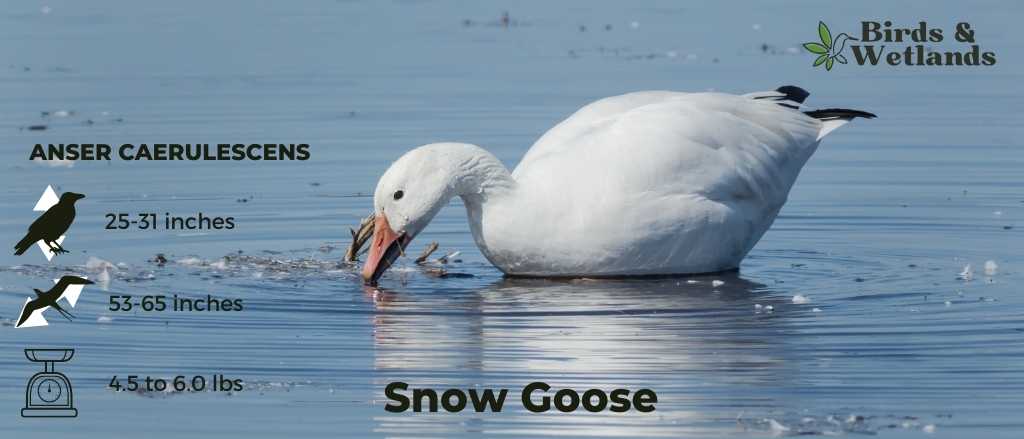
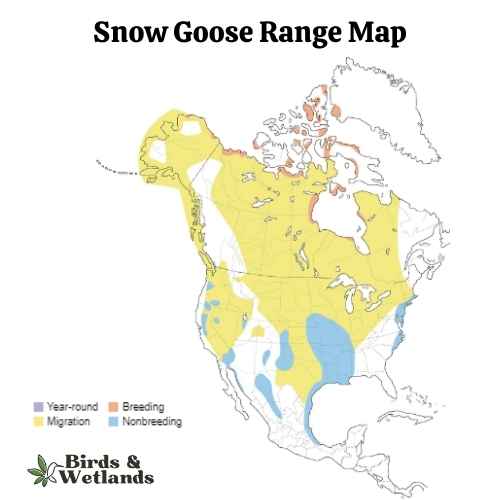
Snow Goose Sound
Scientific Name: Anser caerulescens
Length: 25 to 31 in
Wingspan: 53 to 65 in
Weight: 4.5 to 6.0
The Snow Goose is a large species of waterfowl known for its vibrant white plumage and significant migratory flights.
Appearance: True to their name, Snow Geese are predominantly white with black wingtips. They also have a pink bill, pink legs and feet. A color morph, known as the “Blue Goose,” displays a bluish-gray body with a white head, but is considered the same species.
Diet: Snow Geese primarily feed on plant matter, such as grasses, sedges, and small grains. They can often be seen in large flocks foraging in fields and marshes, and during migration and winter, they can cause considerable damage to agricultural fields due to their feeding habits.
Reproduction: Snow Geese typically nest on the tundra, near water bodies. The female builds the nest and lays a clutch of about 3 to 5 eggs, which she incubates alone for approximately three weeks. Once hatched, the goslings can feed themselves but stay with their parents for protection until they can fly.
Where Can you Find Geese in Oklahoma
Geese can be found throughout the state, the Oklahoma Department of Wildlife Conservation state that they are usually found near bodies of water, lakes, ponds, wetlands and artificial water bodies. They have adapted well to urban areas including parks and golf courses.
Are There Resident Geese Flocks in Oklahoma
Yes there are resident canada geese flocks in Oklahoma, usually the giant Canada goose as these birds are less migratory than the other geese species. Migratory birds usually leave in early summer and return in November.
The resident flocks can be a nuisance if the geese are nesting on your property. You can call out authorised firms to relocate the geese and conduct nest control. Goose droppings can be hazardous (see Goose Droppings: Can Geese Carry Rabies?) and geese can be aggressive to humans if you get close to their nests.
There are several ways to discourage geese from your property (see our guide to getting rid of geese) and we strongly advise that you do not feed the geese (especially not bread!).
Can You Hunt Geese in Oklahoma
Yes, although geese are protected by the Migratory Bird treaty act, these migratory game birds make for great waterfowl hunting in the state. Goose hunting is allowed in the regular waterfowl season, as Oklahoma is part of the central flyway.
However to take part in the hunting season you need a permit, you can only shoot within the hunting season dates (which change each year and are detailed by the migratory bird coordinator), and you are limited to a daily bag limit and a possession limits. Check the different dates for zones 1 and 2 in the Panhandle counties. You can find the latest dates and bag limits here.
Shotgun hunting is allowed with a federally approved nontoxic shot and youth hunters have a reduced licence fee but must be accompanied by a hunter education certified adult who hunts waterfowl. Electronic bird calls are also permitted.
Many local hunting tours operate goose hunting in Texas and Oklahoma. Geese hunting in Arkansas also has similar dates and limits.

